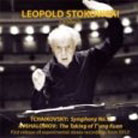May 2008
Mark Obert-Thorn, who made the transfers for this CD release, writes that Whyte used a tape recorder with staggered heads in order to avoid crosstalk; this called for synchronizing the delay between the two channels, as well as several other bits of noise elimination and general cleanup. The applause was left in the Detroit material, including an outburst after the Symphony’s first movement. Otherwise the sound is generally quite good for stereo vintage 1952 -- definitely cleaner and less dry in the Smetana piece than on Mercury’s own monophonic CD reissue of the entire Má vlast, and with instruments in both orchestras clearly and accurately positioned. Both Stokowski items, however, are conspicuously dry-sounding, to the disadvantage of Jacob Avshalomov’s brief but colorful piece. There is some overloading in Tchaikovsky’s big climaxes, and Obert-Thorn notes instances of dropout that could not be fixed. The performance differs in several respects from Stokowski’s various commercial recordings of the Fifth, but is consistently exciting, with fine playing from all sections and beautifully sustained momentum throughout. This is hardly a recommendation as a "basic" Tchaikovsky Fifth, but as a document of the pre-natal period of modern stereophonic recordings, this is an intriguing addition to Stokowski’s huge discography. GO BACK TO: |
 Tchaikovsky - Symphony No. 5 in E
minor
Tchaikovsky - Symphony No. 5 in E
minor